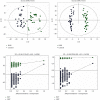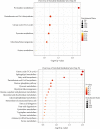Study on the Characteristics of Traditional Chinese Medicine Syndromes in Patients with Erosive Gastritis Based on Metabolomics
- PMID: 38204992
- PMCID: PMC10776191
- DOI: 10.1155/2024/6684677
Study on the Characteristics of Traditional Chinese Medicine Syndromes in Patients with Erosive Gastritis Based on Metabolomics
Abstract
According to traditional Chinese medicine theory, tongue coatings reflect changes in the body. The goal of this study was to identify a metabolite or a set of metabolites capable of classifying characteristics of traditional Chinese medicine syndromes in erosive gastritis. In this study, we collected tongue coatings of patients with erosive gastritis with damp-heat syndrome (DHS), liver depression and qi stagnation syndrome (LDQSS), and healthy volunteers. Then, we analyzed the differences in metabolic characteristics between the two groups based on metabolomics. We identified 14 potential biomarkers related to the DHS group, and six metabolic pathways were enriched. The differential pathways included pyrimidine metabolism, pantothenate and CoA biosynthesis, citrate cycle (TCA cycle), pyruvate metabolism, glycolysis/gluconeogenesis, and purine metabolism. Similarly, in the LDQSS group, we identified 25 potential biomarkers and 18 metabolic pathways were enriched. The top five pathways were the TCA cycle, sphingolipid metabolism, fatty acid biosynthesis, pantothenate and CoA biosynthesis, and the pentose phosphate pathway. In conclusion, the DHS group and the LDQSS group have different characteristics.
Copyright © 2024 Zhang Shixiong et al.
Conflict of interest statement
The authors declare that they have no conflicts of interest.
Figures








Similar articles
-
Serum metabolomics analysis of biomarkers and metabolic pathways in patients with colorectal cancer associated with spleen-deficiency and qi-stagnation syndrome or damp-heat syndrome: a prospective cohort study.Front Oncol. 2023 Sep 12;13:1190706. doi: 10.3389/fonc.2023.1190706. eCollection 2023. Front Oncol. 2023. PMID: 37771438 Free PMC article.
-
Exploring the "gene-protein-metabolite" network of coronary heart disease with phlegm and blood stasis syndrome by integrated multi-omics strategy.Front Pharmacol. 2022 Nov 29;13:1022627. doi: 10.3389/fphar.2022.1022627. eCollection 2022. Front Pharmacol. 2022. PMID: 36523490 Free PMC article.
-
Identification of the Biomarkers for Chronic Gastritis with TCM Damp Phlegm Pattern by Using Tongue Coating Metabolomics.J Inflamm Res. 2024 Nov 2;17:8027-8045. doi: 10.2147/JIR.S480307. eCollection 2024. J Inflamm Res. 2024. PMID: 39507266 Free PMC article.
-
Exploring the effect of the Uyghur medicine Munziq Balgam on a collagen-induced arthritis rat model by UPLC-MS/MS-based metabolomics approach.J Ethnopharmacol. 2023 Jun 28;310:116437. doi: 10.1016/j.jep.2023.116437. Epub 2023 Mar 26. J Ethnopharmacol. 2023. PMID: 36977448
-
[Characteristics of traditional Chinese medicine syndromes and their element distributions in sub-health status: a modern literature review].Zhong Xi Yi Jie He Xue Bao. 2008 Dec;6(12):1290-3. doi: 10.3736/jcim20081216. Zhong Xi Yi Jie He Xue Bao. 2008. PMID: 19063846 Review. Chinese.
Cited by
-
Different lysine-to-methionine ratios in a low-protein diet affect the microbiome and metabolome, influencing the jejunal barrier function in Tibetan sheep.Front Microbiol. 2025 Feb 12;16:1441143. doi: 10.3389/fmicb.2025.1441143. eCollection 2025. Front Microbiol. 2025. PMID: 40012772 Free PMC article.
-
Insights on the Biomarker Identification for Chronic Gastritis with TCM Damp Phlegm Pattern [Letter].J Inflamm Res. 2024 Nov 22;17:9507-9508. doi: 10.2147/JIR.S506160. eCollection 2024. J Inflamm Res. 2024. PMID: 39600679 Free PMC article. No abstract available.
-
Clinical study of intelligent tongue diagnosis and oral microbiome for classifying TCM syndromes in MASLD.Chin Med. 2025 May 29;20(1):78. doi: 10.1186/s13020-025-01118-w. Chin Med. 2025. PMID: 40442807 Free PMC article.
References
-
- Mohammed S. H., Conrad C., Kjaergaad J. Erosive gastritis. European Journal of Radiology . 1982;2(3):205–208. - PubMed
-
- Romero-Vazquez J., Arguelles-Arias F., Garcia-Montes J. M., Caunedo-Alvarez A., Pellicer-Bautista F. J., Herrerias-Gutierrez J. M. Capsule endoscopy in patients refusing conventional endoscopy. World Journal of Gastroenterology . 2014;20(23):7424–7433. doi: 10.3748/wjg.v20.i23.7424. - DOI - PMC - PubMed
LinkOut - more resources
Full Text Sources

